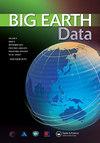GIScience research challenges for realizing discrete global grid systems as a Digital Earth
IF 3.8
3区 地球科学
Q1 COMPUTER SCIENCE, INFORMATION SYSTEMS
引用次数: 13
Abstract
ABSTRACT Increasing data resources are available for documenting and detecting changes in environmental, ecological, and socioeconomic processes. Currently, data are distributed across a wide variety of sources (e.g. data silos) and published in a variety of formats, scales, and semantic representations. A key issue, therefore, in building systems that can realize a vision of earth system monitoring remains data integration. Discrete global grid systems (DGGSs) have emerged as a key technology that can provide a common multi-resolution spatial fabric in support of Digital Earth monitoring. However, DGGSs remain in their infancy with many technical, conceptual, and operational challenges. With renewed interest in DGGS brought on by a recently proposed standard, the demands of big data, and growing needs for monitoring environmental changes across a variety of scales, we seek to highlight current challenges that we see as central to moving the field(s) and technologies of DGGS forward. For each of the identified challenges, we illustrate the issue and provide a potential solution using a reference DGGS implementation. Through articulation of these challenges, we hope to identify a clear research agenda, expand the DGGS research footprint, and provide some ideas for moving forward towards a scaleable Digital Earth vision. Addressing such challenges helps the GIScience research community to achieve the real benefits of DGGS and provides DGGS an opportunity to play a role in the next generation of GIS.实现离散全球网格系统作为数字地球的gisscience研究挑战
越来越多的数据资源可用于记录和检测环境、生态和社会经济过程的变化。目前,数据分布在各种各样的来源(例如数据筒仓)上,并以各种格式、规模和语义表示发布。因此,在构建能够实现地球系统监测愿景的系统时,一个关键问题是数据集成。离散全球网格系统(DGGSs)已经成为一项关键技术,它可以提供支持数字地球监测的通用多分辨率空间结构。然而,dggs仍处于起步阶段,面临许多技术、概念和操作方面的挑战。由于最近提出的标准、大数据的需求以及监测各种尺度环境变化的需求不断增长,人们对DGGS重新产生了兴趣,我们试图强调当前的挑战,我们认为这些挑战是推动DGGS领域和技术向前发展的核心。对于每一个确定的挑战,我们都说明了问题,并使用参考DGGS实现提供了一个潜在的解决方案。通过对这些挑战的阐述,我们希望确定一个明确的研究议程,扩大DGGS的研究足迹,并为实现可扩展的数字地球愿景提供一些想法。解决这些挑战有助于地理信息系统科学研究界实现DGGS的真正好处,并为DGGS提供了在下一代地理信息系统中发挥作用的机会。
本文章由计算机程序翻译,如有差异,请以英文原文为准。
求助全文
约1分钟内获得全文
求助全文
来源期刊

Big Earth Data
Earth and Planetary Sciences-Computers in Earth Sciences
CiteScore
7.40
自引率
10.00%
发文量
60
审稿时长
10 weeks
 求助内容:
求助内容: 应助结果提醒方式:
应助结果提醒方式:


